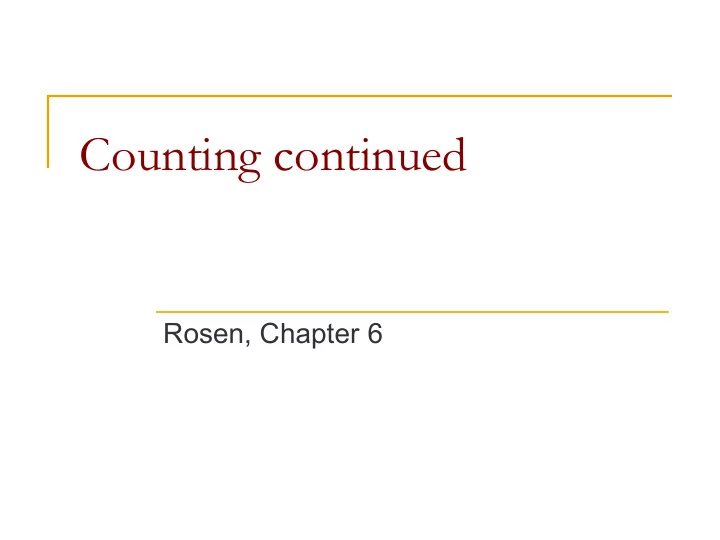

Counting continued Rosen, Chapter 6
Generalized pigeon hole principle There are 10 pigeons and 3 holes, what can we say?
Generalized pigeon hole principle There are 10 pigeons and 3 holes, what can we say? at least one hole has at least 4 pigeons N objects placed in k boxes, then N / k at least one box has at least objects
Examples 100 people, at least how many are born in the same month? What is the minimum # students such that 6 get the same grade? (A,B,C,D,F) ask yourself: what are the pigeons, what are the holes
Permutations In a family of 5, how many ways can we arrange the members of the family in a line for a photograph?
Permutations A permutation of a set of distinct objects is an ordered arrangement of these objects. Example: (1, 3, 2, 4) is a permutation of the numbers 1, 2, 3, 4 How many permutations of n objects are there?
How many permutations How many permutations of n objects are there? Using the product rule: n . (n – 1) . (n – 2) ,…, 2 . 1 = n!
The Traveling Salesman Problem (TSP) TSP: Given a list of cities and their pairwise distances, find a shortest possible tour that visits each city exactly once. Objective: find a permutation a 1 ,…,a n of the cities that minimizes An optimal TSP tour through where d(i, j) i s the distance between Germany’s 15 largest cities cities i and j
Solving TSP Go through all permutations of cities, and evaluate the sum-of-distances, keeping the optimal tour. Need a method for generating all permutations Note: how many solutions to a TSP problem with n cities?
Generating Permutations Let's design a recursive algorithm that starts with permutation [0,1,2,3,..,n-1] which elements should be placed in position 0? what needs to be done next? what is the base case? Let's write the program....
r-permutations An ordered arrangement of r elements of a set: r-permutations of a set with n elements: P(n,r) Example: List the 2-permutations of {a,b,c}. P(3,2) = 3 x 2 = 6 Let n and r be integers such that 0 ≤ r ≤ n then there are P(n,r) = n (n – 1)… ( n – r + 1) r-permutations of a set with n elements. P(n, r) = n! / (n – r)!
r-permutations - example How many ways are there to select a first- prize winner, a second prize winner and a third prize winner from 100 people who have entered a contest?
Combinations How many poker hands (five cards) can be dealt from a deck of 52 cards? How is this different than r-permutations?
Combinations The number of r-combinations out of a set with n elements: C(n,r) also denoted as: Example: {1,3,4} is a 3-combination of {1,2,3,4} Example: How many 2-combinations of {a,b,c,d}
r-combinations How many r-combinations? Notice: We can prove that without using the formula
Unordered versus ordered selections Two ordered selections are the same if the elements chosen are the same; the elements chosen are in the same order. Ordered selections : r-permutations . Two unordered selections are the same if the elements chosen are the same. (regardless of the order in which the elements are chosen) Unordered selections: r-combinations. 16
Relationship between P(n,r) and C(n,r) Suppose we want to compute P(n,r) . Constructing an r-permutation from a set of n elements can be thought as a 2-step process: Step 1: Choose a subset of r elements; Step 2: Choose an ordering of the r-element subset. Step 1 can be done in C(n,r) different ways. Step 2 can be done in r! different ways. Based on the multiplication rule, P(n,r) = C(n,r ) ∙ r! Thus P ( n , r ) n ! C ( n , r ) r ! r ! ( n r )! 17
r-combinations Example: How many bit strings of length n contain exactly r ones? Count the r-combinations for r from 0 to n What do you get? Does that make sense?
Some Advice about Counting Apply the multiplication rule if The elements to be counted can be obtained through a multistep selection process. Each step is performed in a fixed number of ways regardless of how preceding steps were performed. Apply the addition rule if The set of elements to be counted can be broken up into disjoint subsets Apply the inclusion/exclusion rule if It is simple to over-count and then to subtract duplicates 19
Some more advice about Counting Make sure that 1) every element is counted; 2) no element is counted more than once. (avoid double counting) When using the addition rule: 1) every outcome should be in some subset; 2) the subsets should be disjoint; if they are not, subtract the overlaps 20
Example using Inclusion/Exclusion Rule Question: How many integers from 1 through 100 are multiples of 4 or multiples of 7 ? Solution: Let A be the set of integers from 1 through 100 which are multiples of 4; B be the set of integers from 1 through 100 which are multiples of 7. A B is the set of integers from 1 through 100 which are multiples of 4 and 7 hence multiples of 28. We want to find |A B|.
Recommend
More recommend